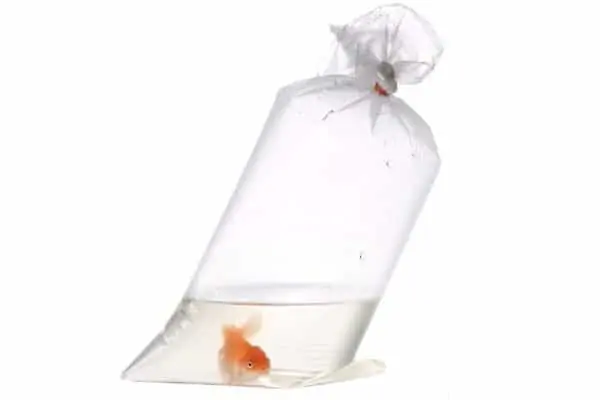If you’re planning to bring fish on a plane, whether alive or dead, this guide has you covered.
While taking your pet goldfish on vacation might sound unusual, you never know when you might want your aquatic friend by your side! We’ll also delve into the specific rules and restrictions you need to know, especially for international travel with live fish.
Read on for everything you need to navigate your fishy travels smoothly.

The Quick Answer: Can you bring live fish on a plane? TSA regulations allow live fish to be taken through airport security and onto a plane in your carry on bags but they must be in a spill-proof clear transparent container. They are not allowed in checked bags. You should check with your airline to ensure they also allow them.

Contents
Can you take fish through airport security
Live fish are allowed through the checkpoint according to the Transportation Security Administration with the following restrictions:
- The fish must be in a clear, transparent, spill-proof container
- The fish must be alive and swimming
- They can be in more than 3.4 ozs of water as the liquids rule is waived when transporting live fish
- You must notify a transportation security officer that you have them, as they will carry out a visual inspection
Dead fish can be taken through the security checkpoint in your carry-on baggage. When wrapping fish, ensure that it is well packed in a sealable plastic bag, as no one wants to sit through an entire flight with a fish smell in the air, particularly if it is not very fresh fish.
If the fish is packed in ice, dry ice, or ice packs, it must not be melted at all when presented at the security checkpoint (i.e., there can be no liquid water), as that is not permitted.
Fish should pass through the X-ray machine fine, with no ill effects.
The final decision rests with the TSA officer regarding what can and cannot be taken through.
You may also be interested in my post – Can you bring seashells on a plane?
@AskTSA Service
The TSA offers very good service on Twitter and Facebook. You can ask a specific question about whether you can take something through the security checkpoint, and they will respond quickly.
This is in response to a passenger’s question regarding transporting fish:

Can you take live fish onboard?
Although you may be able to take live fish through airport security, that doesn’t mean you can take them on the aircraft with you. It is possible that some airline rules might not allow live fish in the cabin, so you should always check with your airline beforehand to make sure.
I have read that Southwest Airlines does not allow live fish to be taken on a flight, so you should check with them if you intend to.
Of course, your hand luggage will not be searched again after you pass through airport security, so if you have fish inside your bag and they remain in the bag for the flight, then the airline will be unlikely to know that you have them.

Can you take fish in your checked bags?
Live fish are not allowed to be carried in checked baggage (and rightly so, in my opinion).
Checked luggage can get rough treatment through the baggage handling systems, often tumbling end over end, so any live fish in them would probably be injured or killed.
At least in your hand luggage, they can be treated much more gently.
You can pack dead fish in your suitcase, such as those you may have caught while fishing.
How to transport live fish on a plane
As already stated above, living fish should be in a clear, transparent container that cannot spill water in the plane. They can be transported in special aquatic “breather” bags, allowing oxygen and carbon dioxide to pass through the bag’s surface but not water (very clever technology).
If you plan to take live tropical fish, unless it is a very short flight, the water temperature may vary too much for the poor fish to survive.
You can buy these on Amazon – Breather Bags for Shipment or Transportation of Fish
- Although the bags are quite durable, you can protect them more by placing them inside a container, but ensure that some of the bag (at the top) is exposed to the air. Otherwise, oxygen won’t be able to pass through.
- Ideally, you should only pack one fish in a bag, particularly if it is larger or prone to fight. However, you may put more in one bag if it is small and non-aggressive.
- Do not feed the fish for 24 hours before transporting them, as this will mean they are less likely to soil the water as much, keeping it fresher for longer.
- Try to minimize the transportation period as much as possible.
- Fill the bags fully, as this will prevent the water from sloshing around, which can damage the fish. The exception is when transporting Betta fish, in which case you should ensure that the bag or container is not full and there is air space, as Betta fish breathe from the surface, too. You may need a larger breather bag to achieve this.
I asked the TSA specifically if these were permitted through airport security, and this was their reply:

Can you take live fish internationally?
Most countries have regulations regarding importing live fish; you may need the appropriate permits to take them into the country.
There are various restrictions if flying into the US with live fish from another country. You should contact the US Fish and Wildlife Service. This article by Aquafind gives some good information on importing tropical fish – Importing Tropical Fish (Summary of US Rules).
If you are flying out of the US into another country and want to take fish with you, you should contact the embassy of that country.
Export permits may be required for some types of fish when crossing national borders.
Conclusion
A common question is, “Can you take a fish on a plane?” The answer is yes. You can bring live fish when flying. However, certain rules and regulations must be followed to ensure a smooth and safe journey for your aquatic companions.
Firstly, if you’re wondering, “Can you bring a betta fish on a plane?” the good news is that betta fish are generally allowed on flights. These beautiful and resilient fish can be transported in a small, secure container that meets the airline’s guidelines for carry-on items.
Can you take frozen fish on a plane? The situation is a bit different when it comes to frozen fish. Generally speaking, frozen fish are allowed on flights, but it is crucial to comply with the airline’s regulations. The fish should be properly packaged in a leak-proof and insulated container to prevent any issues during transit.
So, can you carry fish on a plane? Absolutely! Whether it’s a betta fish, goldfish, live fish, or even frozen fish, as long as you adhere to the airline’s rules and ensure the safety and well-being of your aquatic companions, you can fly with fish without any problem.
Can you take live lobsters on a plane?
The TSA allows live lobsters through the security checkpoint in a checked bag and, with an airline’s consent, in your cabin bag. But do the poor lobster a favor and don’t subject it to even more torture before it is eaten!
Can you bring Betta fish on a plane?

Yes, Betta fish can be taken on a plane in hand luggage, but they must be in a clear, transparent, spill-proof container and be presented to security for a visual inspection. They cannot be taken in a checked bag.
Can you bring frozen fish on a plane?
Frozen fish can be taken on a plane as carry-on baggage or checked baggage. If it is in your carry-on and packed in ice, dry ice or ice packs, there must be no melted water with it when it is presented at the security checkpoint.

I have been traveling around the world by air since the early 70s and living overseas too. I worked for British Airways for a number of years and I am also a private pilot. About Me




